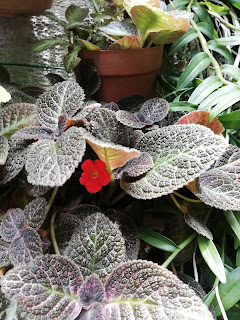It is always taking the risk. You will never know whether they will survive and barely make it or thrive and showcase a grand beauty. Here, I had planted Chocolate Soldier, Strawberry Patch and Malayan Gem.
Eventually the Strawberry Patch gave a beautiful growth and formation until rodents and cats started to messing around on this flower bed and it proved fatal for the whole collection.
I had reset them again and replanted using Monet stolons here and they had flooded the space beautifully with the green and silver tones.
I would encourage you to try this set-up if you have spare stolons to grow.
Do place them on top of a heap of pebbles that cascade down in a slope. You don't have to worry about soil medium as they will do just fine.
The only thing you have to aware of it the placement - find the most humid area in your garden. I would recommend nearby a water source areas like drainside or pond areas.
That would be the most ideal places.
Very much earlier I had planted begonias and Coleus but it didn't seemed to do so well for it's either too wet or too dry during the day. These Episcias handled it well as carpet plant trailing and well growing as ground covers.
You can notice the Begonias and Coleus, the remnants of earlier planted shoots that suddenly showed up after episcias started to thrive. Sometimes, letting them grow and taking their own course is more rewarding especially for this particular species.
UPDATED DECEMBER 2019
It has been like a year cultivating this particular episcia and I wanted to write some updates about my experience on this one. Here, I had planted them on pebbles and had let the stolons to trail and grow freely without any pruning.
These grew so well and easily but after about 6 months or so, they showed signs of distress and require pruning and re-planting as these plants become so leggy and messy. If failed to do so, the plant slowly succumb to withering and slow death - the plant sort-off terminate just below the root ball and that is the end of the plant if not checked or inspected.
Their care & needs are similar to begonias - high humidity, shade loving plant and proper feeding regime to ensure stability and well balanced plant.
The earlier cutivation of Malayan Gem and Strawberry Mist was not so successful for the second reset.
Below are the pictures about the episcia in my garden in this one year duration:


































































